Cadbury's Marketing Strategy: Segmentation, Targeting, and Positioning
VerifiedAdded on 2020/11/12
|14
|4139
|453
Report
AI Summary
This report provides a comprehensive analysis of Cadbury's marketing strategy. It begins with an introduction to marketing strategy and its application to Cadbury, a major player in the confectionery industry. The report then delves into environmental analysis using PESTLE and SWOT frameworks, assessing political, economic, social, technological, legal, and environmental factors, as well as internal strengths, weaknesses, opportunities, and threats. The report evaluates Cadbury's current marketing strategy, focusing on segmentation, targeting, and positioning (STP) and the marketing mix. Competitive advantages, such as distribution and brand equity, are also discussed. Furthermore, the report examines product rationale and specification using the BCG matrix to analyze product portfolios and identify cash cows, stars, question marks, and dogs. The report concludes with recommendations for marketing objectives and goals, providing a well-rounded view of Cadbury's marketing approach.
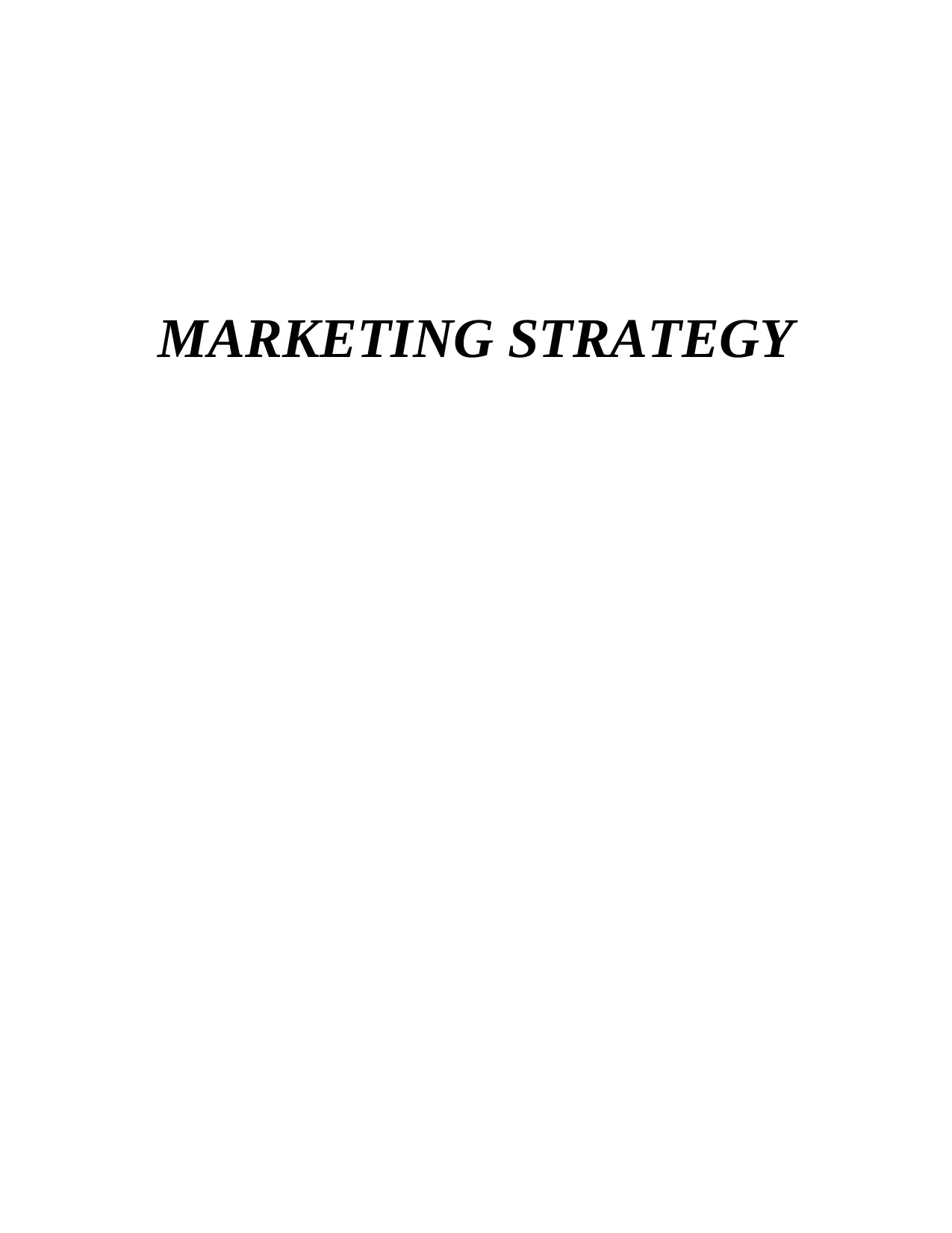
MARKETING STRATEGY
Paraphrase This Document
Need a fresh take? Get an instant paraphrase of this document with our AI Paraphraser
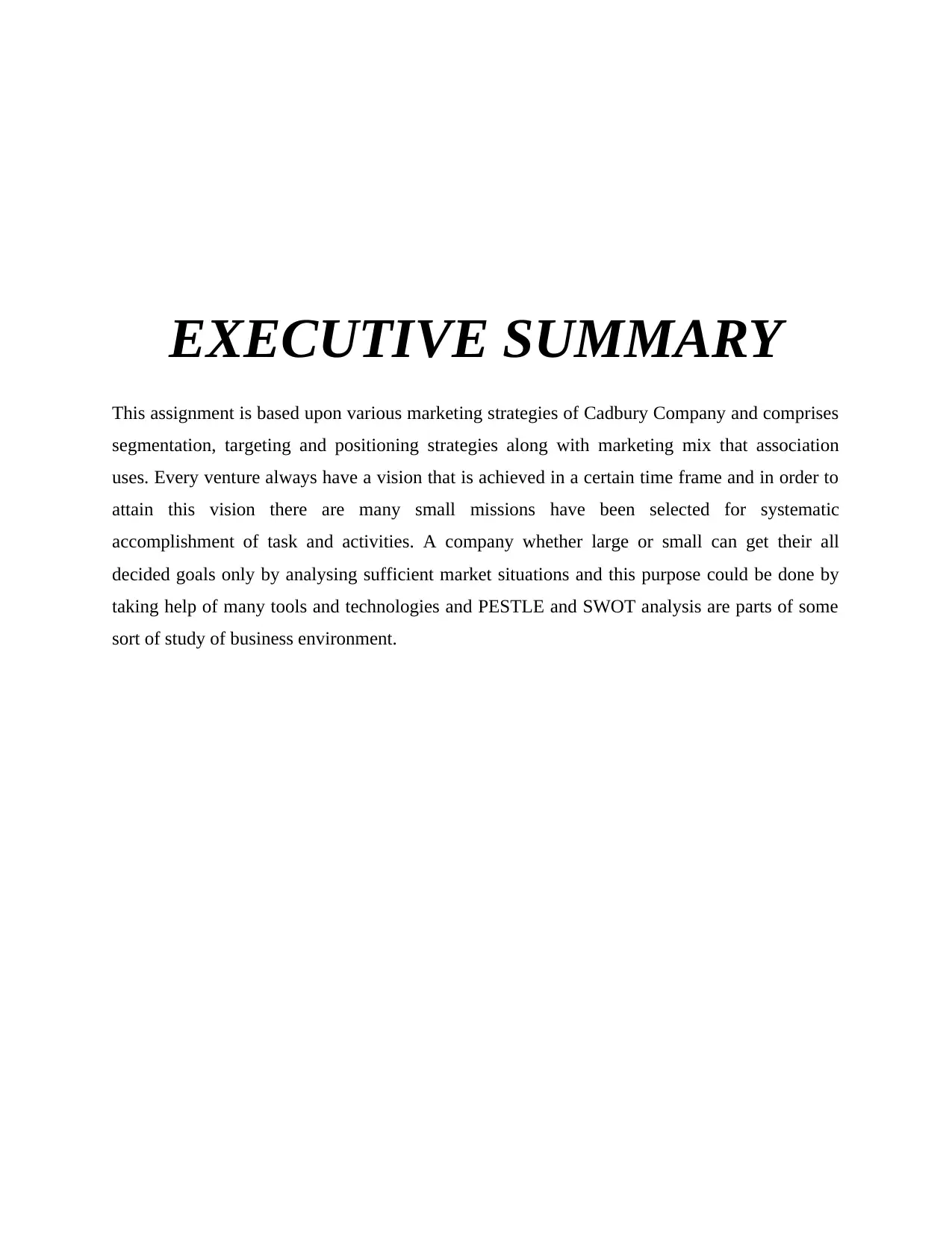
EXECUTIVE SUMMARY
This assignment is based upon various marketing strategies of Cadbury Company and comprises
segmentation, targeting and positioning strategies along with marketing mix that association
uses. Every venture always have a vision that is achieved in a certain time frame and in order to
attain this vision there are many small missions have been selected for systematic
accomplishment of task and activities. A company whether large or small can get their all
decided goals only by analysing sufficient market situations and this purpose could be done by
taking help of many tools and technologies and PESTLE and SWOT analysis are parts of some
sort of study of business environment.
This assignment is based upon various marketing strategies of Cadbury Company and comprises
segmentation, targeting and positioning strategies along with marketing mix that association
uses. Every venture always have a vision that is achieved in a certain time frame and in order to
attain this vision there are many small missions have been selected for systematic
accomplishment of task and activities. A company whether large or small can get their all
decided goals only by analysing sufficient market situations and this purpose could be done by
taking help of many tools and technologies and PESTLE and SWOT analysis are parts of some
sort of study of business environment.
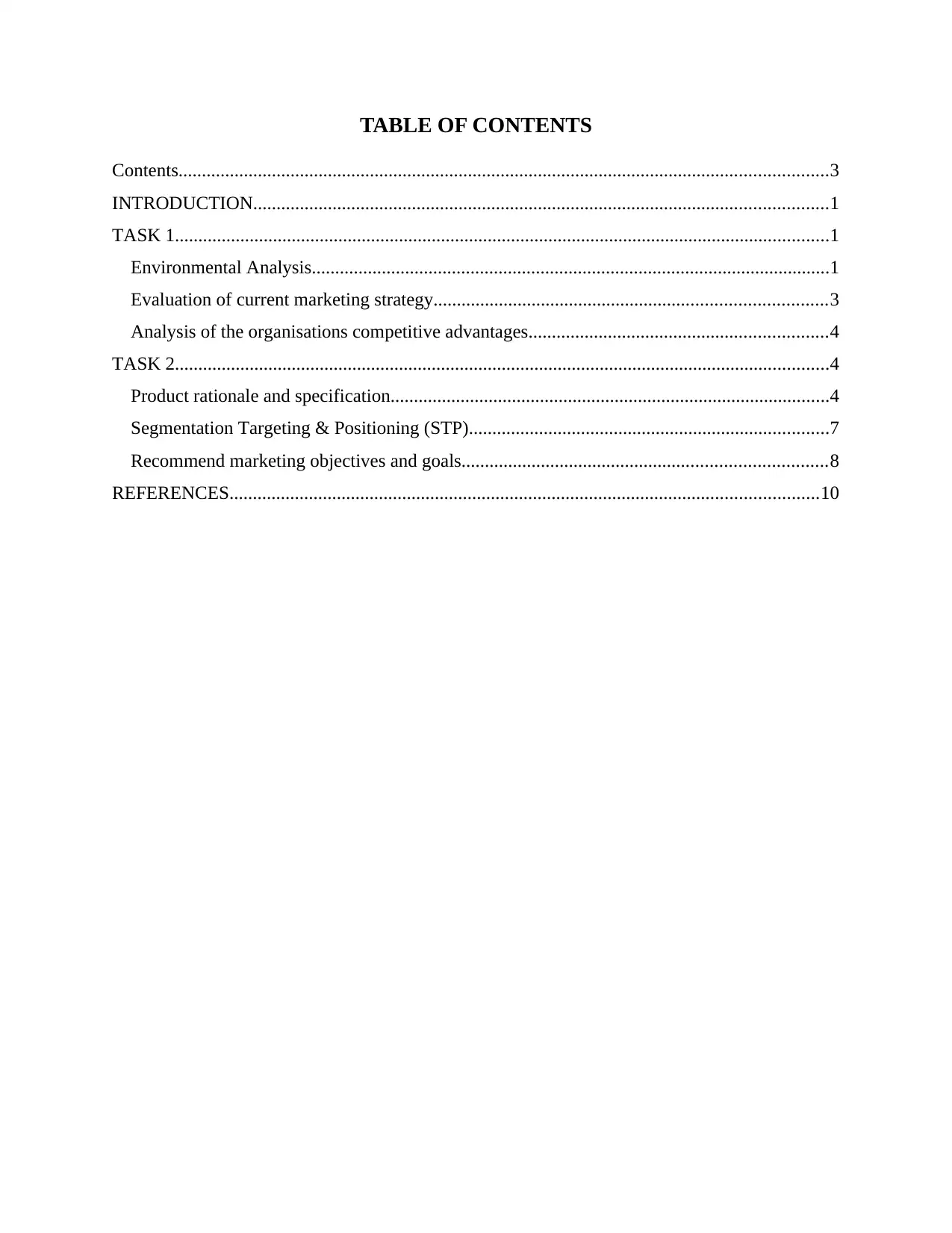
TABLE OF CONTENTS
Contents...........................................................................................................................................3
INTRODUCTION...........................................................................................................................1
TASK 1............................................................................................................................................1
Environmental Analysis...............................................................................................................1
Evaluation of current marketing strategy....................................................................................3
Analysis of the organisations competitive advantages................................................................4
TASK 2............................................................................................................................................4
Product rationale and specification..............................................................................................4
Segmentation Targeting & Positioning (STP).............................................................................7
Recommend marketing objectives and goals..............................................................................8
REFERENCES..............................................................................................................................10
Contents...........................................................................................................................................3
INTRODUCTION...........................................................................................................................1
TASK 1............................................................................................................................................1
Environmental Analysis...............................................................................................................1
Evaluation of current marketing strategy....................................................................................3
Analysis of the organisations competitive advantages................................................................4
TASK 2............................................................................................................................................4
Product rationale and specification..............................................................................................4
Segmentation Targeting & Positioning (STP).............................................................................7
Recommend marketing objectives and goals..............................................................................8
REFERENCES..............................................................................................................................10
⊘ This is a preview!⊘
Do you want full access?
Subscribe today to unlock all pages.

Trusted by 1+ million students worldwide
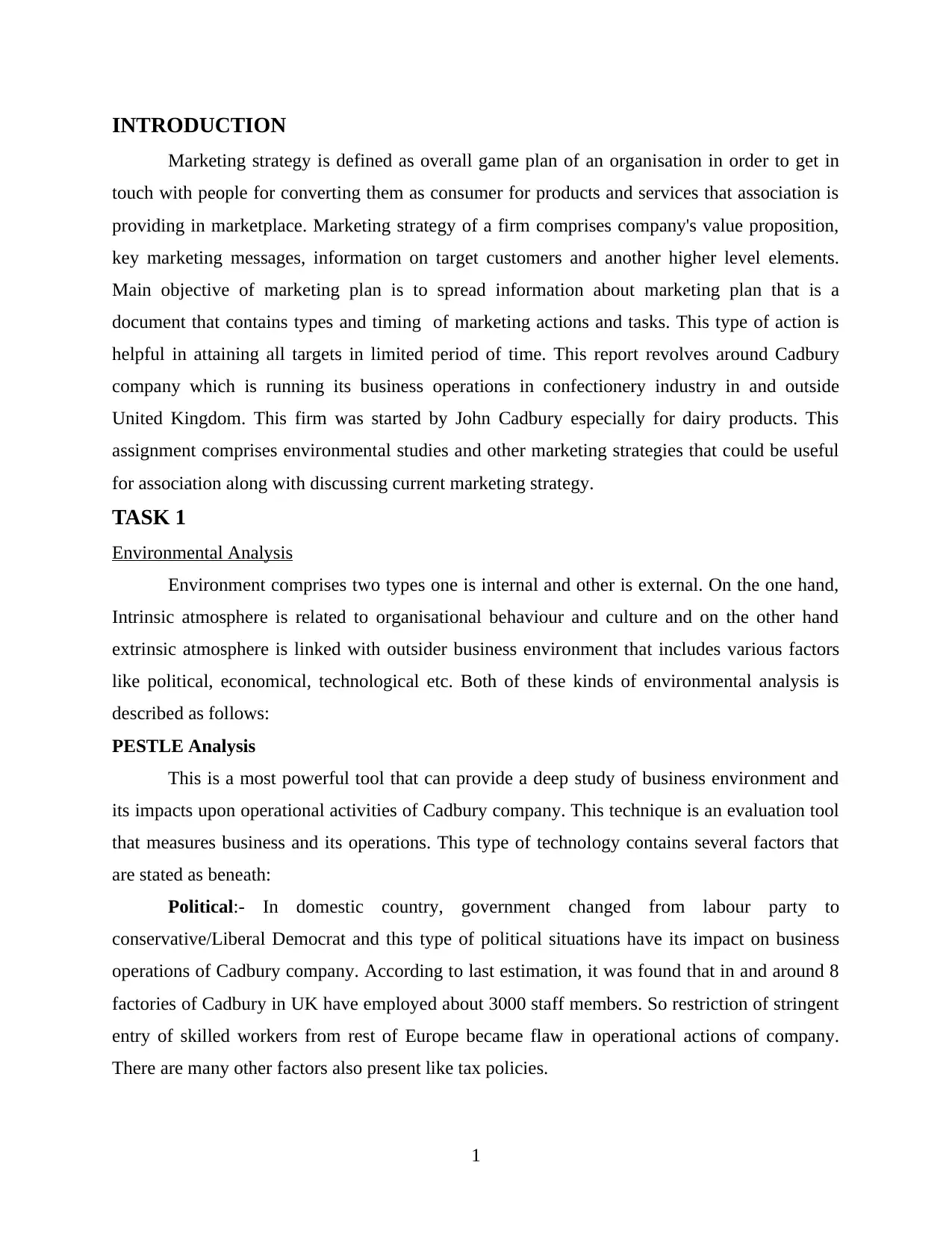
INTRODUCTION
Marketing strategy is defined as overall game plan of an organisation in order to get in
touch with people for converting them as consumer for products and services that association is
providing in marketplace. Marketing strategy of a firm comprises company's value proposition,
key marketing messages, information on target customers and another higher level elements.
Main objective of marketing plan is to spread information about marketing plan that is a
document that contains types and timing of marketing actions and tasks. This type of action is
helpful in attaining all targets in limited period of time. This report revolves around Cadbury
company which is running its business operations in confectionery industry in and outside
United Kingdom. This firm was started by John Cadbury especially for dairy products. This
assignment comprises environmental studies and other marketing strategies that could be useful
for association along with discussing current marketing strategy.
TASK 1
Environmental Analysis
Environment comprises two types one is internal and other is external. On the one hand,
Intrinsic atmosphere is related to organisational behaviour and culture and on the other hand
extrinsic atmosphere is linked with outsider business environment that includes various factors
like political, economical, technological etc. Both of these kinds of environmental analysis is
described as follows:
PESTLE Analysis
This is a most powerful tool that can provide a deep study of business environment and
its impacts upon operational activities of Cadbury company. This technique is an evaluation tool
that measures business and its operations. This type of technology contains several factors that
are stated as beneath:
Political:- In domestic country, government changed from labour party to
conservative/Liberal Democrat and this type of political situations have its impact on business
operations of Cadbury company. According to last estimation, it was found that in and around 8
factories of Cadbury in UK have employed about 3000 staff members. So restriction of stringent
entry of skilled workers from rest of Europe became flaw in operational actions of company.
There are many other factors also present like tax policies.
1
Marketing strategy is defined as overall game plan of an organisation in order to get in
touch with people for converting them as consumer for products and services that association is
providing in marketplace. Marketing strategy of a firm comprises company's value proposition,
key marketing messages, information on target customers and another higher level elements.
Main objective of marketing plan is to spread information about marketing plan that is a
document that contains types and timing of marketing actions and tasks. This type of action is
helpful in attaining all targets in limited period of time. This report revolves around Cadbury
company which is running its business operations in confectionery industry in and outside
United Kingdom. This firm was started by John Cadbury especially for dairy products. This
assignment comprises environmental studies and other marketing strategies that could be useful
for association along with discussing current marketing strategy.
TASK 1
Environmental Analysis
Environment comprises two types one is internal and other is external. On the one hand,
Intrinsic atmosphere is related to organisational behaviour and culture and on the other hand
extrinsic atmosphere is linked with outsider business environment that includes various factors
like political, economical, technological etc. Both of these kinds of environmental analysis is
described as follows:
PESTLE Analysis
This is a most powerful tool that can provide a deep study of business environment and
its impacts upon operational activities of Cadbury company. This technique is an evaluation tool
that measures business and its operations. This type of technology contains several factors that
are stated as beneath:
Political:- In domestic country, government changed from labour party to
conservative/Liberal Democrat and this type of political situations have its impact on business
operations of Cadbury company. According to last estimation, it was found that in and around 8
factories of Cadbury in UK have employed about 3000 staff members. So restriction of stringent
entry of skilled workers from rest of Europe became flaw in operational actions of company.
There are many other factors also present like tax policies.
1
Paraphrase This Document
Need a fresh take? Get an instant paraphrase of this document with our AI Paraphraser
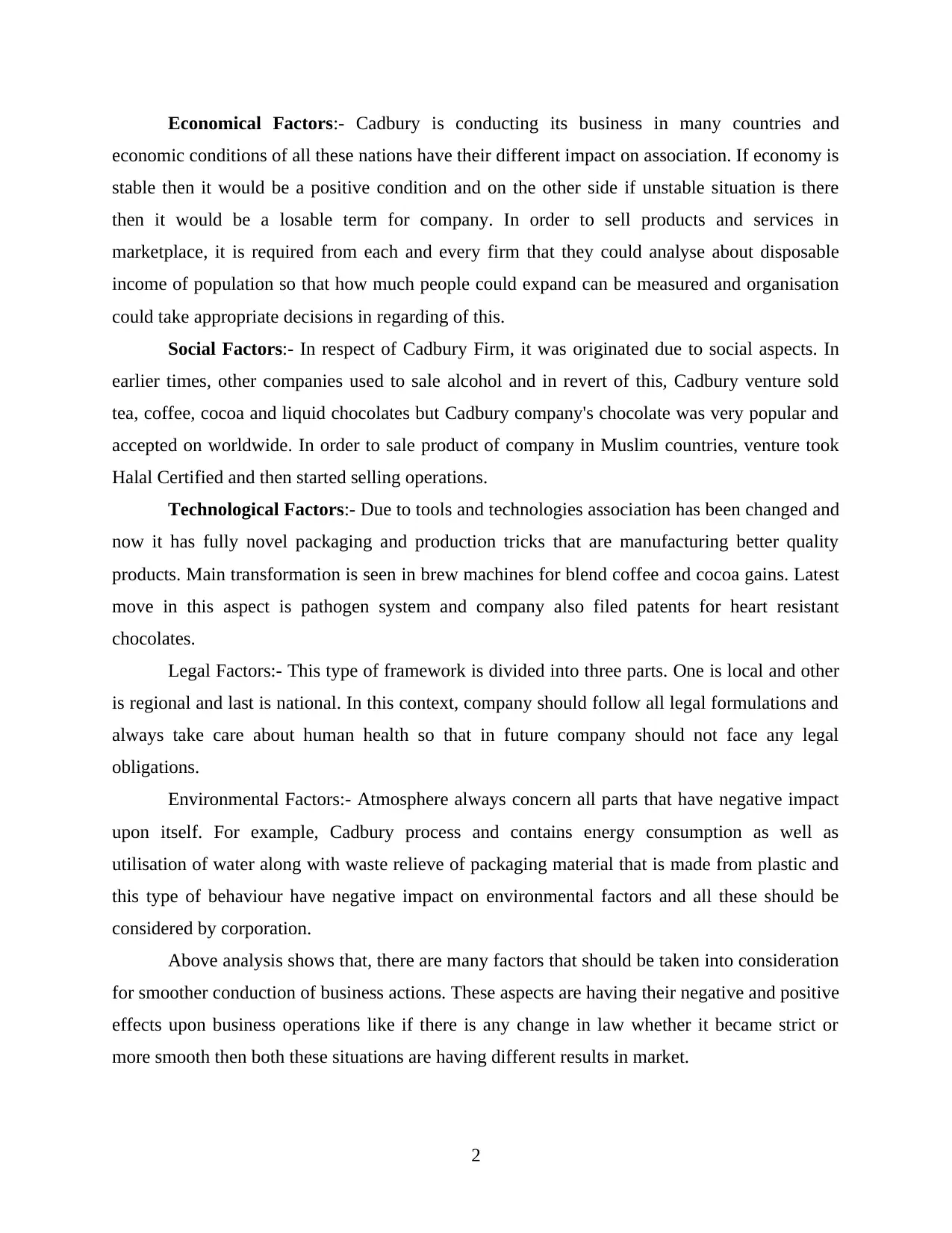
Economical Factors:- Cadbury is conducting its business in many countries and
economic conditions of all these nations have their different impact on association. If economy is
stable then it would be a positive condition and on the other side if unstable situation is there
then it would be a losable term for company. In order to sell products and services in
marketplace, it is required from each and every firm that they could analyse about disposable
income of population so that how much people could expand can be measured and organisation
could take appropriate decisions in regarding of this.
Social Factors:- In respect of Cadbury Firm, it was originated due to social aspects. In
earlier times, other companies used to sale alcohol and in revert of this, Cadbury venture sold
tea, coffee, cocoa and liquid chocolates but Cadbury company's chocolate was very popular and
accepted on worldwide. In order to sale product of company in Muslim countries, venture took
Halal Certified and then started selling operations.
Technological Factors:- Due to tools and technologies association has been changed and
now it has fully novel packaging and production tricks that are manufacturing better quality
products. Main transformation is seen in brew machines for blend coffee and cocoa gains. Latest
move in this aspect is pathogen system and company also filed patents for heart resistant
chocolates.
Legal Factors:- This type of framework is divided into three parts. One is local and other
is regional and last is national. In this context, company should follow all legal formulations and
always take care about human health so that in future company should not face any legal
obligations.
Environmental Factors:- Atmosphere always concern all parts that have negative impact
upon itself. For example, Cadbury process and contains energy consumption as well as
utilisation of water along with waste relieve of packaging material that is made from plastic and
this type of behaviour have negative impact on environmental factors and all these should be
considered by corporation.
Above analysis shows that, there are many factors that should be taken into consideration
for smoother conduction of business actions. These aspects are having their negative and positive
effects upon business operations like if there is any change in law whether it became strict or
more smooth then both these situations are having different results in market.
2
economic conditions of all these nations have their different impact on association. If economy is
stable then it would be a positive condition and on the other side if unstable situation is there
then it would be a losable term for company. In order to sell products and services in
marketplace, it is required from each and every firm that they could analyse about disposable
income of population so that how much people could expand can be measured and organisation
could take appropriate decisions in regarding of this.
Social Factors:- In respect of Cadbury Firm, it was originated due to social aspects. In
earlier times, other companies used to sale alcohol and in revert of this, Cadbury venture sold
tea, coffee, cocoa and liquid chocolates but Cadbury company's chocolate was very popular and
accepted on worldwide. In order to sale product of company in Muslim countries, venture took
Halal Certified and then started selling operations.
Technological Factors:- Due to tools and technologies association has been changed and
now it has fully novel packaging and production tricks that are manufacturing better quality
products. Main transformation is seen in brew machines for blend coffee and cocoa gains. Latest
move in this aspect is pathogen system and company also filed patents for heart resistant
chocolates.
Legal Factors:- This type of framework is divided into three parts. One is local and other
is regional and last is national. In this context, company should follow all legal formulations and
always take care about human health so that in future company should not face any legal
obligations.
Environmental Factors:- Atmosphere always concern all parts that have negative impact
upon itself. For example, Cadbury process and contains energy consumption as well as
utilisation of water along with waste relieve of packaging material that is made from plastic and
this type of behaviour have negative impact on environmental factors and all these should be
considered by corporation.
Above analysis shows that, there are many factors that should be taken into consideration
for smoother conduction of business actions. These aspects are having their negative and positive
effects upon business operations like if there is any change in law whether it became strict or
more smooth then both these situations are having different results in market.
2
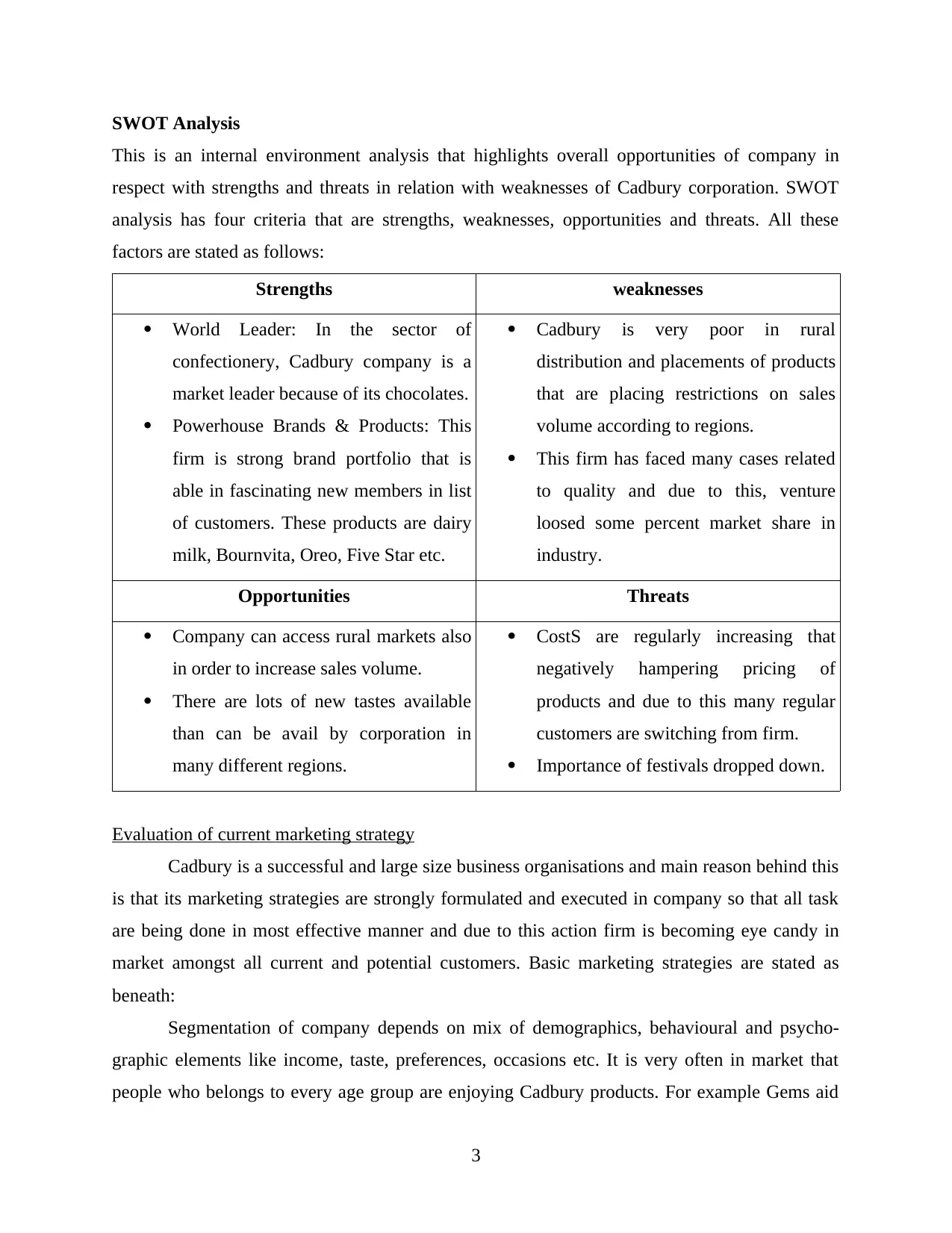
SWOT Analysis
This is an internal environment analysis that highlights overall opportunities of company in
respect with strengths and threats in relation with weaknesses of Cadbury corporation. SWOT
analysis has four criteria that are strengths, weaknesses, opportunities and threats. All these
factors are stated as follows:
Strengths weaknesses
World Leader: In the sector of
confectionery, Cadbury company is a
market leader because of its chocolates.
Powerhouse Brands & Products: This
firm is strong brand portfolio that is
able in fascinating new members in list
of customers. These products are dairy
milk, Bournvita, Oreo, Five Star etc.
Cadbury is very poor in rural
distribution and placements of products
that are placing restrictions on sales
volume according to regions.
This firm has faced many cases related
to quality and due to this, venture
loosed some percent market share in
industry.
Opportunities Threats
Company can access rural markets also
in order to increase sales volume.
There are lots of new tastes available
than can be avail by corporation in
many different regions.
CostS are regularly increasing that
negatively hampering pricing of
products and due to this many regular
customers are switching from firm.
Importance of festivals dropped down.
Evaluation of current marketing strategy
Cadbury is a successful and large size business organisations and main reason behind this
is that its marketing strategies are strongly formulated and executed in company so that all task
are being done in most effective manner and due to this action firm is becoming eye candy in
market amongst all current and potential customers. Basic marketing strategies are stated as
beneath:
Segmentation of company depends on mix of demographics, behavioural and psycho-
graphic elements like income, taste, preferences, occasions etc. It is very often in market that
people who belongs to every age group are enjoying Cadbury products. For example Gems aid
3
This is an internal environment analysis that highlights overall opportunities of company in
respect with strengths and threats in relation with weaknesses of Cadbury corporation. SWOT
analysis has four criteria that are strengths, weaknesses, opportunities and threats. All these
factors are stated as follows:
Strengths weaknesses
World Leader: In the sector of
confectionery, Cadbury company is a
market leader because of its chocolates.
Powerhouse Brands & Products: This
firm is strong brand portfolio that is
able in fascinating new members in list
of customers. These products are dairy
milk, Bournvita, Oreo, Five Star etc.
Cadbury is very poor in rural
distribution and placements of products
that are placing restrictions on sales
volume according to regions.
This firm has faced many cases related
to quality and due to this, venture
loosed some percent market share in
industry.
Opportunities Threats
Company can access rural markets also
in order to increase sales volume.
There are lots of new tastes available
than can be avail by corporation in
many different regions.
CostS are regularly increasing that
negatively hampering pricing of
products and due to this many regular
customers are switching from firm.
Importance of festivals dropped down.
Evaluation of current marketing strategy
Cadbury is a successful and large size business organisations and main reason behind this
is that its marketing strategies are strongly formulated and executed in company so that all task
are being done in most effective manner and due to this action firm is becoming eye candy in
market amongst all current and potential customers. Basic marketing strategies are stated as
beneath:
Segmentation of company depends on mix of demographics, behavioural and psycho-
graphic elements like income, taste, preferences, occasions etc. It is very often in market that
people who belongs to every age group are enjoying Cadbury products. For example Gems aid
3
⊘ This is a preview!⊘
Do you want full access?
Subscribe today to unlock all pages.

Trusted by 1+ million students worldwide
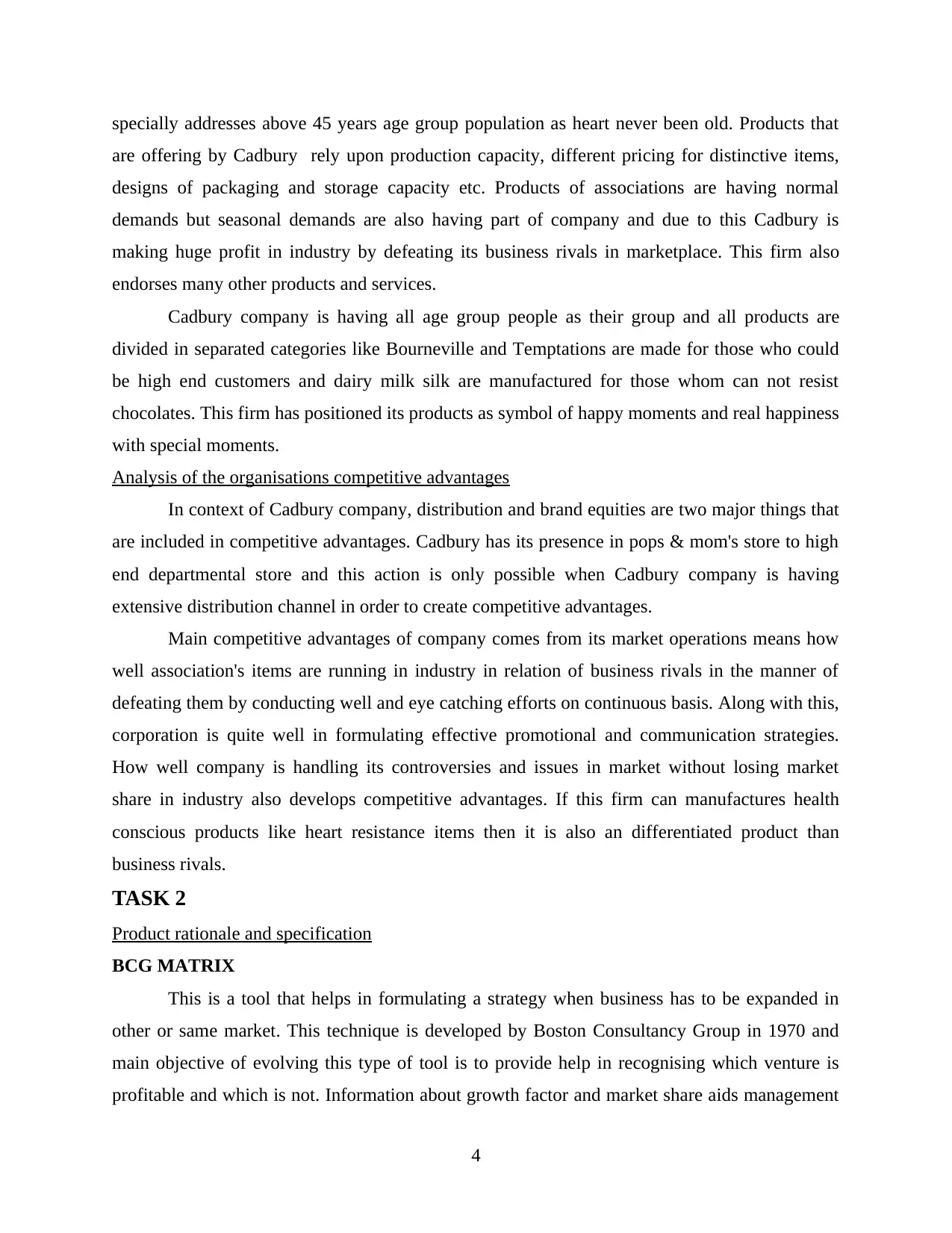
specially addresses above 45 years age group population as heart never been old. Products that
are offering by Cadbury rely upon production capacity, different pricing for distinctive items,
designs of packaging and storage capacity etc. Products of associations are having normal
demands but seasonal demands are also having part of company and due to this Cadbury is
making huge profit in industry by defeating its business rivals in marketplace. This firm also
endorses many other products and services.
Cadbury company is having all age group people as their group and all products are
divided in separated categories like Bourneville and Temptations are made for those who could
be high end customers and dairy milk silk are manufactured for those whom can not resist
chocolates. This firm has positioned its products as symbol of happy moments and real happiness
with special moments.
Analysis of the organisations competitive advantages
In context of Cadbury company, distribution and brand equities are two major things that
are included in competitive advantages. Cadbury has its presence in pops & mom's store to high
end departmental store and this action is only possible when Cadbury company is having
extensive distribution channel in order to create competitive advantages.
Main competitive advantages of company comes from its market operations means how
well association's items are running in industry in relation of business rivals in the manner of
defeating them by conducting well and eye catching efforts on continuous basis. Along with this,
corporation is quite well in formulating effective promotional and communication strategies.
How well company is handling its controversies and issues in market without losing market
share in industry also develops competitive advantages. If this firm can manufactures health
conscious products like heart resistance items then it is also an differentiated product than
business rivals.
TASK 2
Product rationale and specification
BCG MATRIX
This is a tool that helps in formulating a strategy when business has to be expanded in
other or same market. This technique is developed by Boston Consultancy Group in 1970 and
main objective of evolving this type of tool is to provide help in recognising which venture is
profitable and which is not. Information about growth factor and market share aids management
4
are offering by Cadbury rely upon production capacity, different pricing for distinctive items,
designs of packaging and storage capacity etc. Products of associations are having normal
demands but seasonal demands are also having part of company and due to this Cadbury is
making huge profit in industry by defeating its business rivals in marketplace. This firm also
endorses many other products and services.
Cadbury company is having all age group people as their group and all products are
divided in separated categories like Bourneville and Temptations are made for those who could
be high end customers and dairy milk silk are manufactured for those whom can not resist
chocolates. This firm has positioned its products as symbol of happy moments and real happiness
with special moments.
Analysis of the organisations competitive advantages
In context of Cadbury company, distribution and brand equities are two major things that
are included in competitive advantages. Cadbury has its presence in pops & mom's store to high
end departmental store and this action is only possible when Cadbury company is having
extensive distribution channel in order to create competitive advantages.
Main competitive advantages of company comes from its market operations means how
well association's items are running in industry in relation of business rivals in the manner of
defeating them by conducting well and eye catching efforts on continuous basis. Along with this,
corporation is quite well in formulating effective promotional and communication strategies.
How well company is handling its controversies and issues in market without losing market
share in industry also develops competitive advantages. If this firm can manufactures health
conscious products like heart resistance items then it is also an differentiated product than
business rivals.
TASK 2
Product rationale and specification
BCG MATRIX
This is a tool that helps in formulating a strategy when business has to be expanded in
other or same market. This technique is developed by Boston Consultancy Group in 1970 and
main objective of evolving this type of tool is to provide help in recognising which venture is
profitable and which is not. Information about growth factor and market share aids management
4
Paraphrase This Document
Need a fresh take? Get an instant paraphrase of this document with our AI Paraphraser
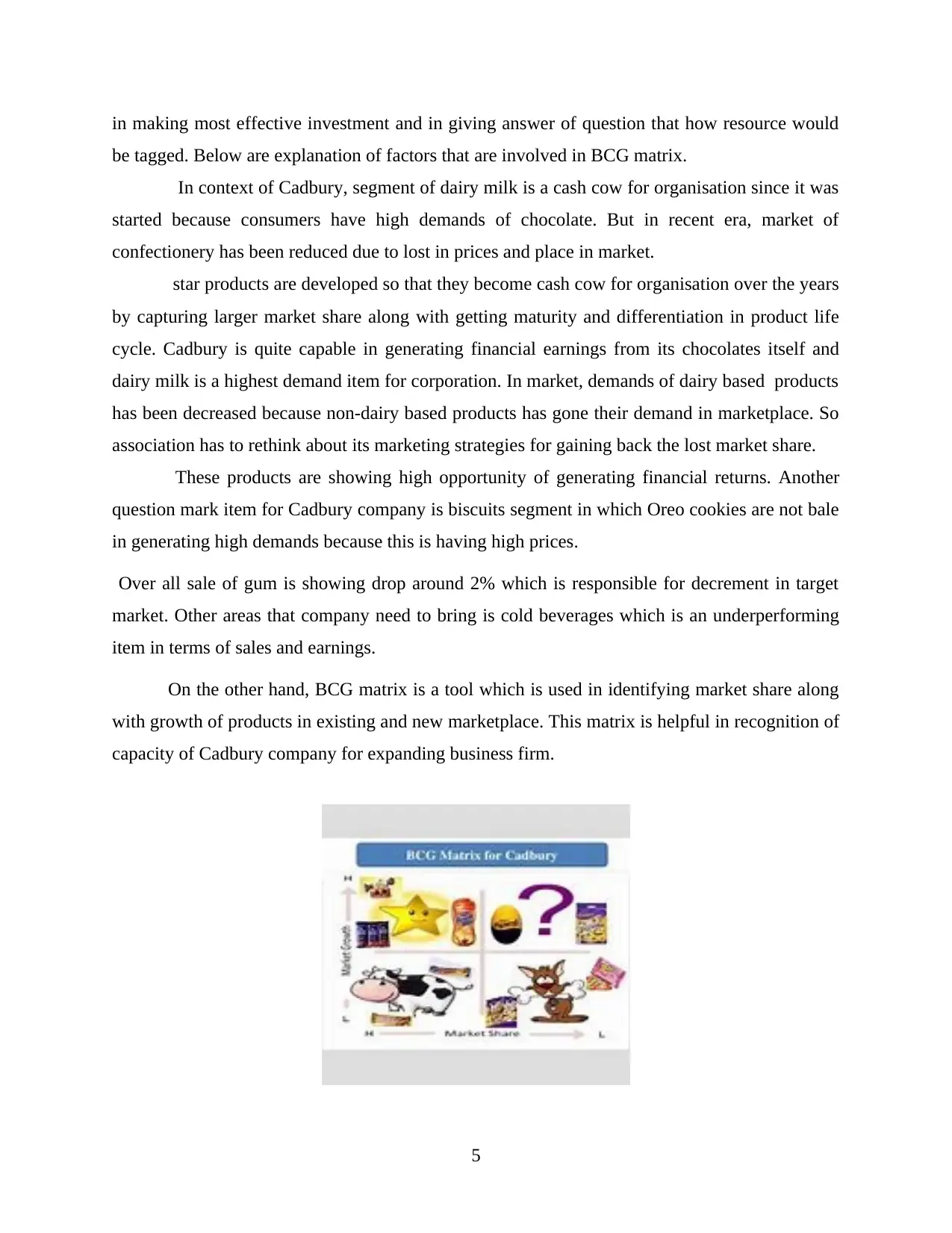
in making most effective investment and in giving answer of question that how resource would
be tagged. Below are explanation of factors that are involved in BCG matrix.
In context of Cadbury, segment of dairy milk is a cash cow for organisation since it was
started because consumers have high demands of chocolate. But in recent era, market of
confectionery has been reduced due to lost in prices and place in market.
star products are developed so that they become cash cow for organisation over the years
by capturing larger market share along with getting maturity and differentiation in product life
cycle. Cadbury is quite capable in generating financial earnings from its chocolates itself and
dairy milk is a highest demand item for corporation. In market, demands of dairy based products
has been decreased because non-dairy based products has gone their demand in marketplace. So
association has to rethink about its marketing strategies for gaining back the lost market share.
These products are showing high opportunity of generating financial returns. Another
question mark item for Cadbury company is biscuits segment in which Oreo cookies are not bale
in generating high demands because this is having high prices.
Over all sale of gum is showing drop around 2% which is responsible for decrement in target
market. Other areas that company need to bring is cold beverages which is an underperforming
item in terms of sales and earnings.
On the other hand, BCG matrix is a tool which is used in identifying market share along
with growth of products in existing and new marketplace. This matrix is helpful in recognition of
capacity of Cadbury company for expanding business firm.
5
be tagged. Below are explanation of factors that are involved in BCG matrix.
In context of Cadbury, segment of dairy milk is a cash cow for organisation since it was
started because consumers have high demands of chocolate. But in recent era, market of
confectionery has been reduced due to lost in prices and place in market.
star products are developed so that they become cash cow for organisation over the years
by capturing larger market share along with getting maturity and differentiation in product life
cycle. Cadbury is quite capable in generating financial earnings from its chocolates itself and
dairy milk is a highest demand item for corporation. In market, demands of dairy based products
has been decreased because non-dairy based products has gone their demand in marketplace. So
association has to rethink about its marketing strategies for gaining back the lost market share.
These products are showing high opportunity of generating financial returns. Another
question mark item for Cadbury company is biscuits segment in which Oreo cookies are not bale
in generating high demands because this is having high prices.
Over all sale of gum is showing drop around 2% which is responsible for decrement in target
market. Other areas that company need to bring is cold beverages which is an underperforming
item in terms of sales and earnings.
On the other hand, BCG matrix is a tool which is used in identifying market share along
with growth of products in existing and new marketplace. This matrix is helpful in recognition of
capacity of Cadbury company for expanding business firm.
5
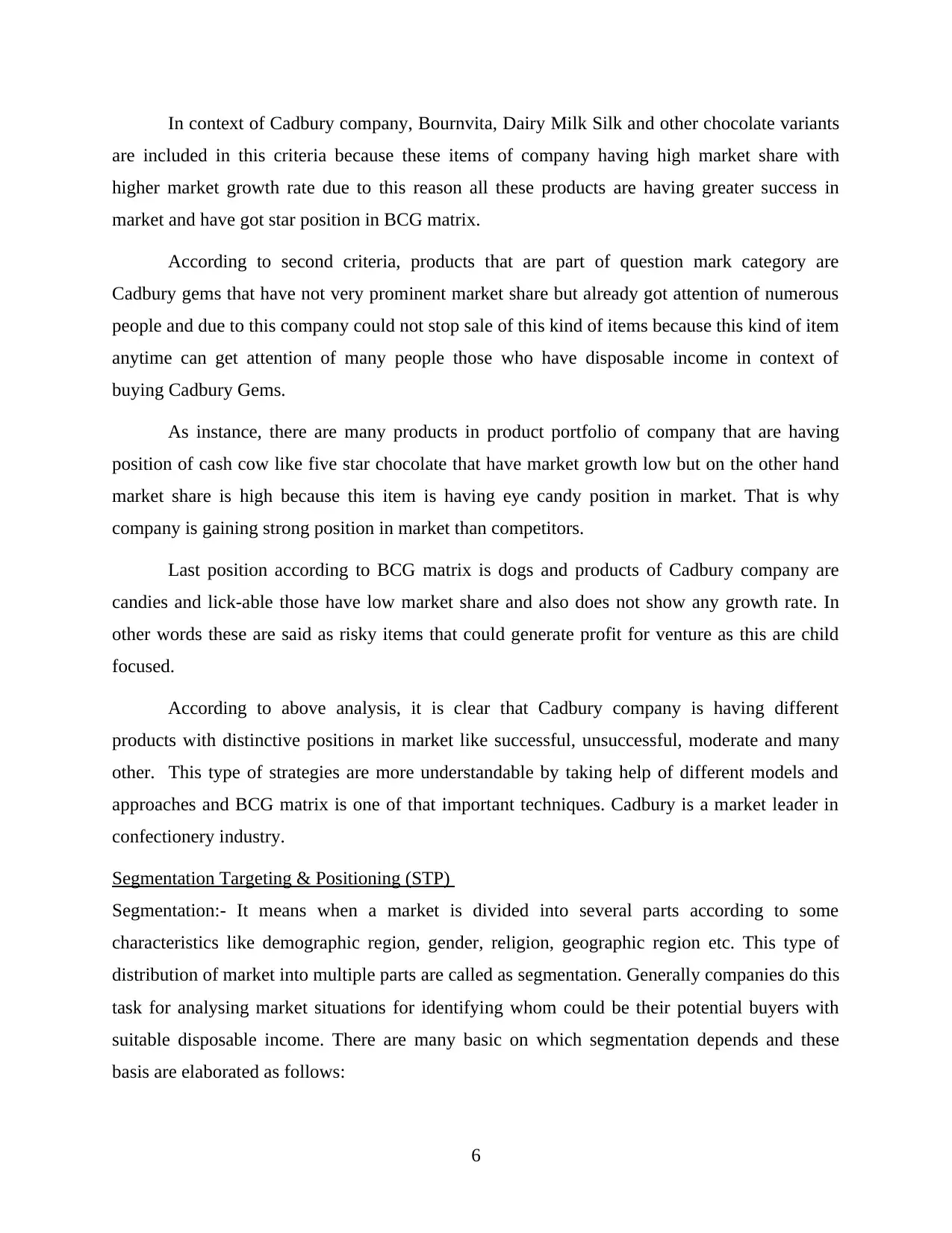
In context of Cadbury company, Bournvita, Dairy Milk Silk and other chocolate variants
are included in this criteria because these items of company having high market share with
higher market growth rate due to this reason all these products are having greater success in
market and have got star position in BCG matrix.
According to second criteria, products that are part of question mark category are
Cadbury gems that have not very prominent market share but already got attention of numerous
people and due to this company could not stop sale of this kind of items because this kind of item
anytime can get attention of many people those who have disposable income in context of
buying Cadbury Gems.
As instance, there are many products in product portfolio of company that are having
position of cash cow like five star chocolate that have market growth low but on the other hand
market share is high because this item is having eye candy position in market. That is why
company is gaining strong position in market than competitors.
Last position according to BCG matrix is dogs and products of Cadbury company are
candies and lick-able those have low market share and also does not show any growth rate. In
other words these are said as risky items that could generate profit for venture as this are child
focused.
According to above analysis, it is clear that Cadbury company is having different
products with distinctive positions in market like successful, unsuccessful, moderate and many
other. This type of strategies are more understandable by taking help of different models and
approaches and BCG matrix is one of that important techniques. Cadbury is a market leader in
confectionery industry.
Segmentation Targeting & Positioning (STP)
Segmentation:- It means when a market is divided into several parts according to some
characteristics like demographic region, gender, religion, geographic region etc. This type of
distribution of market into multiple parts are called as segmentation. Generally companies do this
task for analysing market situations for identifying whom could be their potential buyers with
suitable disposable income. There are many basic on which segmentation depends and these
basis are elaborated as follows:
6
are included in this criteria because these items of company having high market share with
higher market growth rate due to this reason all these products are having greater success in
market and have got star position in BCG matrix.
According to second criteria, products that are part of question mark category are
Cadbury gems that have not very prominent market share but already got attention of numerous
people and due to this company could not stop sale of this kind of items because this kind of item
anytime can get attention of many people those who have disposable income in context of
buying Cadbury Gems.
As instance, there are many products in product portfolio of company that are having
position of cash cow like five star chocolate that have market growth low but on the other hand
market share is high because this item is having eye candy position in market. That is why
company is gaining strong position in market than competitors.
Last position according to BCG matrix is dogs and products of Cadbury company are
candies and lick-able those have low market share and also does not show any growth rate. In
other words these are said as risky items that could generate profit for venture as this are child
focused.
According to above analysis, it is clear that Cadbury company is having different
products with distinctive positions in market like successful, unsuccessful, moderate and many
other. This type of strategies are more understandable by taking help of different models and
approaches and BCG matrix is one of that important techniques. Cadbury is a market leader in
confectionery industry.
Segmentation Targeting & Positioning (STP)
Segmentation:- It means when a market is divided into several parts according to some
characteristics like demographic region, gender, religion, geographic region etc. This type of
distribution of market into multiple parts are called as segmentation. Generally companies do this
task for analysing market situations for identifying whom could be their potential buyers with
suitable disposable income. There are many basic on which segmentation depends and these
basis are elaborated as follows:
6
⊘ This is a preview!⊘
Do you want full access?
Subscribe today to unlock all pages.

Trusted by 1+ million students worldwide
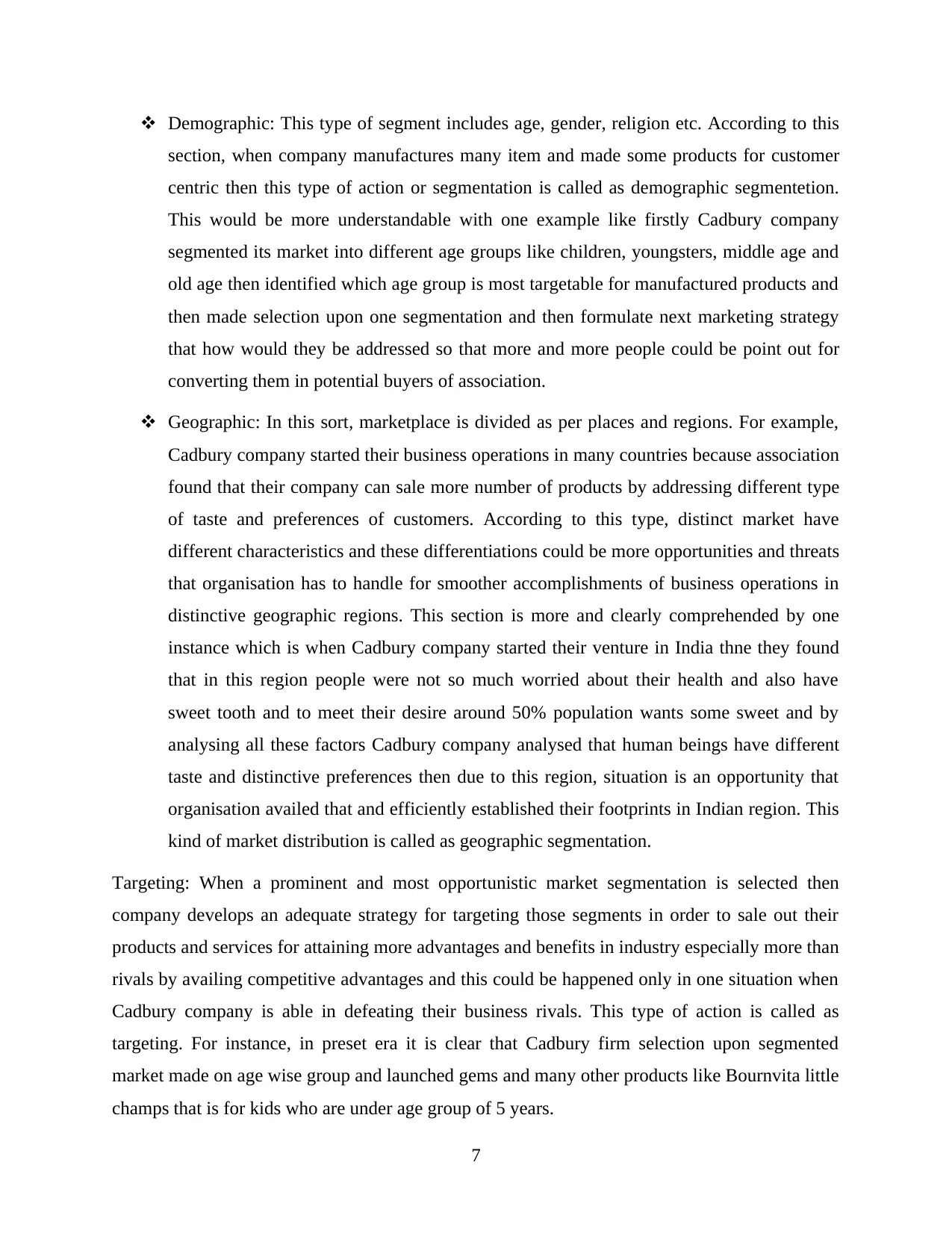
Demographic: This type of segment includes age, gender, religion etc. According to this
section, when company manufactures many item and made some products for customer
centric then this type of action or segmentation is called as demographic segmentetion.
This would be more understandable with one example like firstly Cadbury company
segmented its market into different age groups like children, youngsters, middle age and
old age then identified which age group is most targetable for manufactured products and
then made selection upon one segmentation and then formulate next marketing strategy
that how would they be addressed so that more and more people could be point out for
converting them in potential buyers of association.
Geographic: In this sort, marketplace is divided as per places and regions. For example,
Cadbury company started their business operations in many countries because association
found that their company can sale more number of products by addressing different type
of taste and preferences of customers. According to this type, distinct market have
different characteristics and these differentiations could be more opportunities and threats
that organisation has to handle for smoother accomplishments of business operations in
distinctive geographic regions. This section is more and clearly comprehended by one
instance which is when Cadbury company started their venture in India thne they found
that in this region people were not so much worried about their health and also have
sweet tooth and to meet their desire around 50% population wants some sweet and by
analysing all these factors Cadbury company analysed that human beings have different
taste and distinctive preferences then due to this region, situation is an opportunity that
organisation availed that and efficiently established their footprints in Indian region. This
kind of market distribution is called as geographic segmentation.
Targeting: When a prominent and most opportunistic market segmentation is selected then
company develops an adequate strategy for targeting those segments in order to sale out their
products and services for attaining more advantages and benefits in industry especially more than
rivals by availing competitive advantages and this could be happened only in one situation when
Cadbury company is able in defeating their business rivals. This type of action is called as
targeting. For instance, in preset era it is clear that Cadbury firm selection upon segmented
market made on age wise group and launched gems and many other products like Bournvita little
champs that is for kids who are under age group of 5 years.
7
section, when company manufactures many item and made some products for customer
centric then this type of action or segmentation is called as demographic segmentetion.
This would be more understandable with one example like firstly Cadbury company
segmented its market into different age groups like children, youngsters, middle age and
old age then identified which age group is most targetable for manufactured products and
then made selection upon one segmentation and then formulate next marketing strategy
that how would they be addressed so that more and more people could be point out for
converting them in potential buyers of association.
Geographic: In this sort, marketplace is divided as per places and regions. For example,
Cadbury company started their business operations in many countries because association
found that their company can sale more number of products by addressing different type
of taste and preferences of customers. According to this type, distinct market have
different characteristics and these differentiations could be more opportunities and threats
that organisation has to handle for smoother accomplishments of business operations in
distinctive geographic regions. This section is more and clearly comprehended by one
instance which is when Cadbury company started their venture in India thne they found
that in this region people were not so much worried about their health and also have
sweet tooth and to meet their desire around 50% population wants some sweet and by
analysing all these factors Cadbury company analysed that human beings have different
taste and distinctive preferences then due to this region, situation is an opportunity that
organisation availed that and efficiently established their footprints in Indian region. This
kind of market distribution is called as geographic segmentation.
Targeting: When a prominent and most opportunistic market segmentation is selected then
company develops an adequate strategy for targeting those segments in order to sale out their
products and services for attaining more advantages and benefits in industry especially more than
rivals by availing competitive advantages and this could be happened only in one situation when
Cadbury company is able in defeating their business rivals. This type of action is called as
targeting. For instance, in preset era it is clear that Cadbury firm selection upon segmented
market made on age wise group and launched gems and many other products like Bournvita little
champs that is for kids who are under age group of 5 years.
7
Paraphrase This Document
Need a fresh take? Get an instant paraphrase of this document with our AI Paraphraser
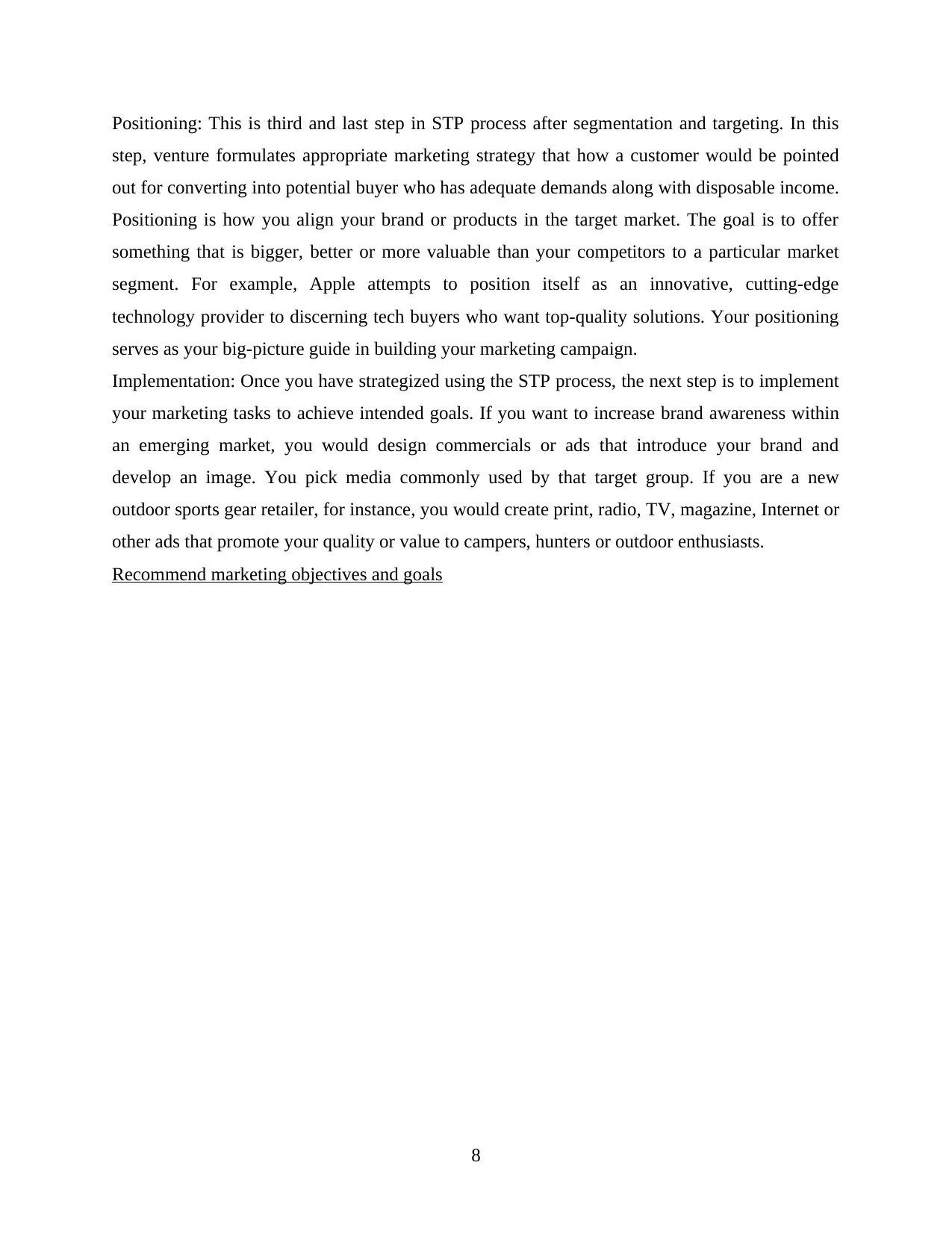
Positioning: This is third and last step in STP process after segmentation and targeting. In this
step, venture formulates appropriate marketing strategy that how a customer would be pointed
out for converting into potential buyer who has adequate demands along with disposable income.
Positioning is how you align your brand or products in the target market. The goal is to offer
something that is bigger, better or more valuable than your competitors to a particular market
segment. For example, Apple attempts to position itself as an innovative, cutting-edge
technology provider to discerning tech buyers who want top-quality solutions. Your positioning
serves as your big-picture guide in building your marketing campaign.
Implementation: Once you have strategized using the STP process, the next step is to implement
your marketing tasks to achieve intended goals. If you want to increase brand awareness within
an emerging market, you would design commercials or ads that introduce your brand and
develop an image. You pick media commonly used by that target group. If you are a new
outdoor sports gear retailer, for instance, you would create print, radio, TV, magazine, Internet or
other ads that promote your quality or value to campers, hunters or outdoor enthusiasts.
Recommend marketing objectives and goals
8
step, venture formulates appropriate marketing strategy that how a customer would be pointed
out for converting into potential buyer who has adequate demands along with disposable income.
Positioning is how you align your brand or products in the target market. The goal is to offer
something that is bigger, better or more valuable than your competitors to a particular market
segment. For example, Apple attempts to position itself as an innovative, cutting-edge
technology provider to discerning tech buyers who want top-quality solutions. Your positioning
serves as your big-picture guide in building your marketing campaign.
Implementation: Once you have strategized using the STP process, the next step is to implement
your marketing tasks to achieve intended goals. If you want to increase brand awareness within
an emerging market, you would design commercials or ads that introduce your brand and
develop an image. You pick media commonly used by that target group. If you are a new
outdoor sports gear retailer, for instance, you would create print, radio, TV, magazine, Internet or
other ads that promote your quality or value to campers, hunters or outdoor enthusiasts.
Recommend marketing objectives and goals
8
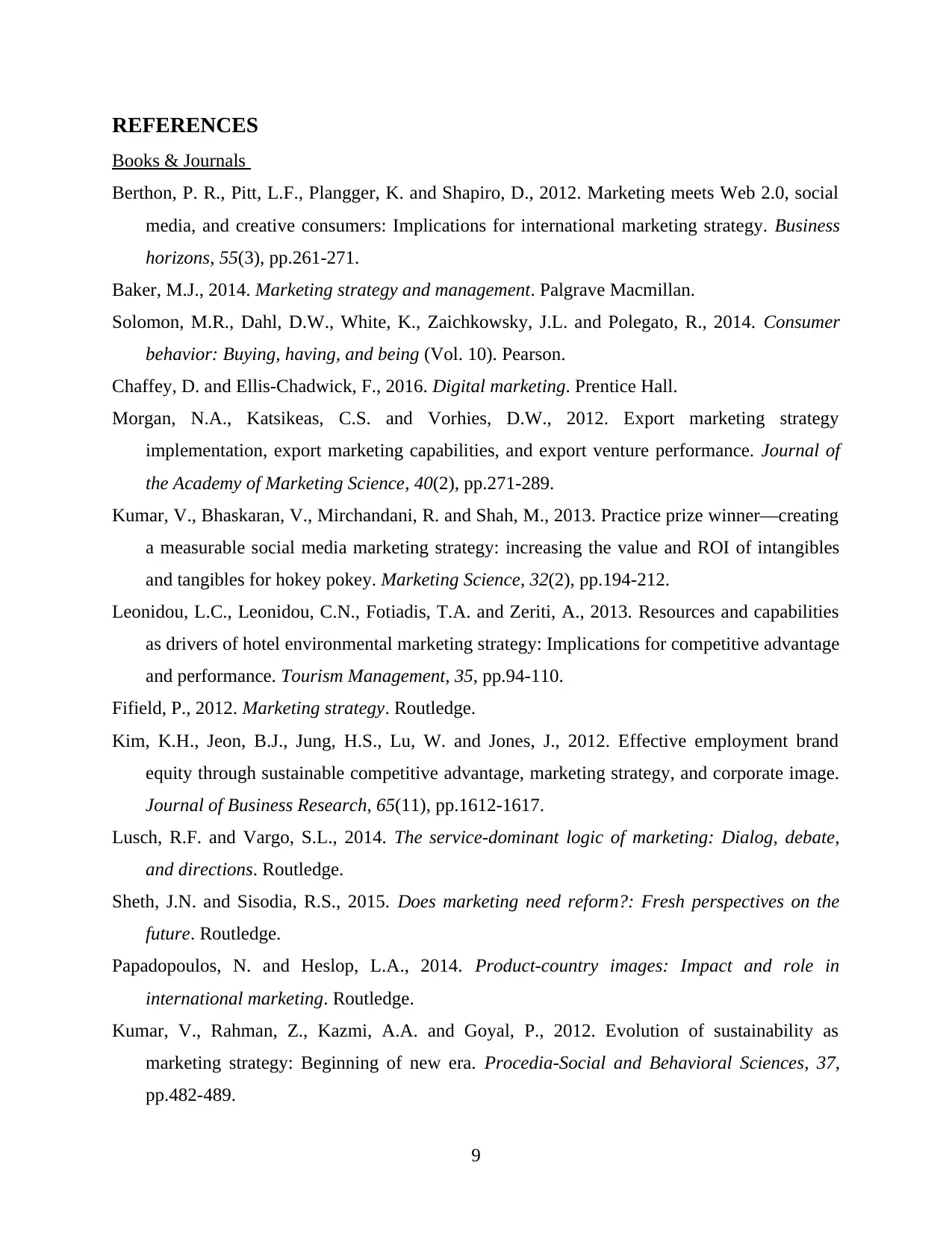
REFERENCES
Books & Journals
Berthon, P. R., Pitt, L.F., Plangger, K. and Shapiro, D., 2012. Marketing meets Web 2.0, social
media, and creative consumers: Implications for international marketing strategy. Business
horizons, 55(3), pp.261-271.
Baker, M.J., 2014. Marketing strategy and management. Palgrave Macmillan.
Solomon, M.R., Dahl, D.W., White, K., Zaichkowsky, J.L. and Polegato, R., 2014. Consumer
behavior: Buying, having, and being (Vol. 10). Pearson.
Chaffey, D. and Ellis-Chadwick, F., 2016. Digital marketing. Prentice Hall.
Morgan, N.A., Katsikeas, C.S. and Vorhies, D.W., 2012. Export marketing strategy
implementation, export marketing capabilities, and export venture performance. Journal of
the Academy of Marketing Science, 40(2), pp.271-289.
Kumar, V., Bhaskaran, V., Mirchandani, R. and Shah, M., 2013. Practice prize winner—creating
a measurable social media marketing strategy: increasing the value and ROI of intangibles
and tangibles for hokey pokey. Marketing Science, 32(2), pp.194-212.
Leonidou, L.C., Leonidou, C.N., Fotiadis, T.A. and Zeriti, A., 2013. Resources and capabilities
as drivers of hotel environmental marketing strategy: Implications for competitive advantage
and performance. Tourism Management, 35, pp.94-110.
Fifield, P., 2012. Marketing strategy. Routledge.
Kim, K.H., Jeon, B.J., Jung, H.S., Lu, W. and Jones, J., 2012. Effective employment brand
equity through sustainable competitive advantage, marketing strategy, and corporate image.
Journal of Business Research, 65(11), pp.1612-1617.
Lusch, R.F. and Vargo, S.L., 2014. The service-dominant logic of marketing: Dialog, debate,
and directions. Routledge.
Sheth, J.N. and Sisodia, R.S., 2015. Does marketing need reform?: Fresh perspectives on the
future. Routledge.
Papadopoulos, N. and Heslop, L.A., 2014. Product-country images: Impact and role in
international marketing. Routledge.
Kumar, V., Rahman, Z., Kazmi, A.A. and Goyal, P., 2012. Evolution of sustainability as
marketing strategy: Beginning of new era. Procedia-Social and Behavioral Sciences, 37,
pp.482-489.
9
Books & Journals
Berthon, P. R., Pitt, L.F., Plangger, K. and Shapiro, D., 2012. Marketing meets Web 2.0, social
media, and creative consumers: Implications for international marketing strategy. Business
horizons, 55(3), pp.261-271.
Baker, M.J., 2014. Marketing strategy and management. Palgrave Macmillan.
Solomon, M.R., Dahl, D.W., White, K., Zaichkowsky, J.L. and Polegato, R., 2014. Consumer
behavior: Buying, having, and being (Vol. 10). Pearson.
Chaffey, D. and Ellis-Chadwick, F., 2016. Digital marketing. Prentice Hall.
Morgan, N.A., Katsikeas, C.S. and Vorhies, D.W., 2012. Export marketing strategy
implementation, export marketing capabilities, and export venture performance. Journal of
the Academy of Marketing Science, 40(2), pp.271-289.
Kumar, V., Bhaskaran, V., Mirchandani, R. and Shah, M., 2013. Practice prize winner—creating
a measurable social media marketing strategy: increasing the value and ROI of intangibles
and tangibles for hokey pokey. Marketing Science, 32(2), pp.194-212.
Leonidou, L.C., Leonidou, C.N., Fotiadis, T.A. and Zeriti, A., 2013. Resources and capabilities
as drivers of hotel environmental marketing strategy: Implications for competitive advantage
and performance. Tourism Management, 35, pp.94-110.
Fifield, P., 2012. Marketing strategy. Routledge.
Kim, K.H., Jeon, B.J., Jung, H.S., Lu, W. and Jones, J., 2012. Effective employment brand
equity through sustainable competitive advantage, marketing strategy, and corporate image.
Journal of Business Research, 65(11), pp.1612-1617.
Lusch, R.F. and Vargo, S.L., 2014. The service-dominant logic of marketing: Dialog, debate,
and directions. Routledge.
Sheth, J.N. and Sisodia, R.S., 2015. Does marketing need reform?: Fresh perspectives on the
future. Routledge.
Papadopoulos, N. and Heslop, L.A., 2014. Product-country images: Impact and role in
international marketing. Routledge.
Kumar, V., Rahman, Z., Kazmi, A.A. and Goyal, P., 2012. Evolution of sustainability as
marketing strategy: Beginning of new era. Procedia-Social and Behavioral Sciences, 37,
pp.482-489.
9
⊘ This is a preview!⊘
Do you want full access?
Subscribe today to unlock all pages.

Trusted by 1+ million students worldwide
1 out of 14
Related Documents
Your All-in-One AI-Powered Toolkit for Academic Success.
+13062052269
info@desklib.com
Available 24*7 on WhatsApp / Email
![[object Object]](/_next/static/media/star-bottom.7253800d.svg)
Unlock your academic potential
Copyright © 2020–2025 A2Z Services. All Rights Reserved. Developed and managed by ZUCOL.




